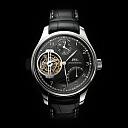Astronomy and timepieces have been intertwined throughout history and its a natural relationship given that all time units are caused by astronomical phenomena. Indeed watchmakers look to this astronomical history for inspiration.
Dutch watchmaker Christiaan van der Klaauw for instance was inspired to create his first astronomical timepieces by Christiaan Huygens (1629-1695), the well-known astronomer and maker of the first pendulum clock. He also drew inspiration from the planetarium built by Eise Eisinga (1744-1828) for his Planetarium watch.
Other brands such as Ulysse Nardin have been inspired to create astronomical watches named after famous astronomers. Three such astronomical watches were the “Astrolabium Galileo Galilei“, the “Planetarium Copernicus” and the “Tellurium Johannes Kepler“, called the Trilogy of Time. The essence of Astronomical watches lies in their interpretation of celestial timekeeping, a combination of horological history and cutting edge technology. They are not only fascinating technical marvels but also interesting tools for astronomical observations.
“Watches with astronomical indications remain among the rarest and most poetic type of complications.” – Patek Phillipe
The result of ten years of research and development the IWC Portuguese Sidérale Scafusia is an astronomical watch that is a technical tour de force and the most complicated watch created by IWC so far. Its a showcase watch that IWC hopes will attract new customers and also a way of displaying IWC`s technical prowess.
A reason for IWC deciding on an astronomical watch would be that astronomical watches have shown to be the most desireable watches to collectors. Astronomical complications possess a mystique and an allure due to their visually exciting displays, rather than their practical application. Given the watches special astronomical functions IWC chose the Paranal Observatory in Chile for its launch.
The new IWC Calibre 94900 movement has over 500 pieces and features a “constant-force” tourbillon, a new technological advancement .
Since the power provided by a mainspring varies dependant on its wound state, the purpose of a constant force escapement is to maintain a constant power rate. This in turn increases the watches accuracy.
The large tourbillon which displays the seconds adorns the front of the watch on the left, along with a subdial at the 12 O’clock position which displays sidereal time (true star time) , solar time and power reserve are also indicated.
The rear of the watch is no less impressive and displays various astronomical data. A section of the night sky is represented by a celestial chart , the location of which is chosen by the customer. According to IWC its capable of displaying between 500 and 1000 stars.
This celestial chart rotates depending on the position of the stars in relation to your position on earth. Surrounding the chart are small hands that indicate sunset/sunrise, day/night, sidereal and solar time. A perpetual calendar is also included at the top of the dial, it displays a count of what number day it is and the leap year.
At the center of the Moonstruck is the earth viewed from the top, pivoting around which are the moon and Earth indicators.
By using two discs that revolve around this central map of the earth, the Moonstruck reproduces the rotation of the Moon around the Earth, as well as the Sun’s relative position.
The moon indicator not only shows you its relative position to earth but through the use of an orb gives you the moon’s phase as well as rather ingeniously revolving so its lit side always faces the sun.
Also featuring a rotating GMT hand and disk , these can be used together with the sun indicator for world time zones.
Features a beautiful mother of pearl dial and ceramic bezel.
jlc-grande-tradition
This celestial time instrument comprises an incredible 527 parts and is testament to formidable technical mastery. Its complexity is due to the combination of three major watch complications, a minute repeater, a flying tourbillon and a zodiac calendar with sidereal time.
It is the only astronomical watch to indicate celestial time through use of a flying tourbillon which moves round the dial once every 23 hours, 56 minutes and 4 seconds indicating true time or sidereal time. Astronomers use the sidereal unit to track the direction of stars. Most wristwatches typically display mean time.
This most distinguishing design feature revolves round a dial which is intricately decorated with star charts on the beautiful blue lustre of the laquered face.
The dial is intricately decorated with important celestial information and blue lustre
 Registracija
Registracija Help
Help


 5Likes
5Likes LinkBack URL
LinkBack URL About LinkBacks
About LinkBacks










 Odgovor sa citatom
Odgovor sa citatom



Bookmarks sajtovi